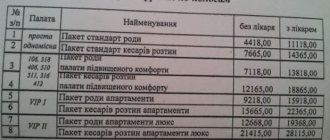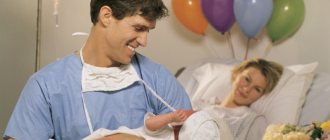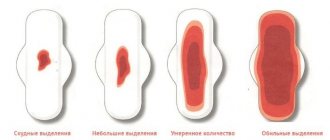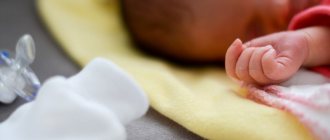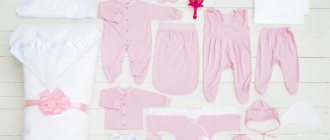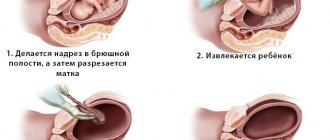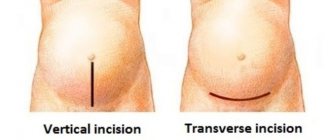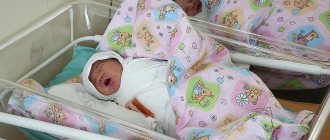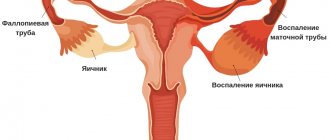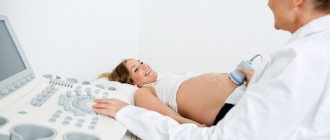By about -35 weeks, expectant mothers should already prepare the things that will go with them to the maternity hospital. It is better to do this in advance, since pregnancy is still an unpredictable process and it is impossible to completely eliminate unforeseen situations, especially if the woman in labor is recommended to have a cesarean section. Undoubtedly, the answer to the question “what to take to the maternity hospital for a caesarean section?” directly depends on the rules adopted in the obstetrics system.
In different maternity hospitals, the list of things may vary, but the basic set still remains the same. Be sure to tell your loved ones where the collected delivery bag is, then, if necessary, they can quickly bring it to you.
When to pack your bag for the maternity hospital?
The date of the cesarean section is negotiated with the obstetrician-gynecologist who is managing the pregnancy, so most often the woman clearly knows what date she needs to be prepared for. However, it is necessary to provide for an option in which labor begins earlier than the appointed date (and the likelihood that this can happen is quite high), and then the cesarean operation will be performed on an emergency basis. Therefore, I recommend having a fully assembled bag by the end of the 35th week, so that everything you need is at hand at any time.
Has your doctor already given you a list for the maternity hospital?
Not really
Set of things for a child
- Separately, you should collect things for the child. What should you take to the maternity hospital for a newborn for caesarean section:
- A package of diapers for newborns.
- Clothes for a child – 1–2 hats, 6–7 pcs. rompers or overalls, 6–7 pcs. vest/shirts and mittens so that the newborn does not scratch his face.
- Cloth and disposable diapers.
- Hygiene products – baby powder, cream, cotton swabs and pads, aspirator, pacifier, baby towel, napkins.
- Diaper cream - the baby's first stool is called meconium, it is very sticky, so a special diaper cream will be useful.
- Nail scissors.
One of the most important tasks is to preserve breast milk and establish feeding. This is where silicone breast pads and a breast pump will come in very handy.
General recommendations
Each maternity hospital may have its own specifics for surgical intervention and hygienic care for the baby, so you should definitely take a list of things to the maternity hospital for a caesarean section in the hospital where you plan to give birth. Most of the items in it, of course, are standard, but the list of necessary items will insure you and your family from unforeseen experiences and hassles at the most crucial moment.
You should not take too many things, as this may make it difficult to store them and find what you need later. Make it a rule to only put in your bag what you will absolutely use. If you have doubts about whether this item will be needed or not, it is better not to clutter the space and leave it at home.
Another important recommendation is that the expectant mother should pack her bag for the maternity hospital herself, as this will allow her to clearly know what is where and not waste time searching later.
Clothing, linen in the postpartum department
- Robe and nightgown. You can use those given at the maternity hospital, or you can take your own. A nightgown in the postpartum ward is preferable to trousers and a T-shirt. The elastic from the bru can put pressure on the seam. In addition, you will often have to change pads, go to procedures and see a gynecologist. You can purchase a special shirt with slits for feeding. The advantage of “maternity hospital” clothes is that they are changed for clean ones every day.
- Postpartum pads. Fortunately, today almost all maternity hospitals allow the use of postpartum pads. You can buy special ones, or you can use night ones. Please note that the surface of the gaskets is “breathable” and not mesh.
- Holders for gaskets. They look like panties made of elastic mesh. A very convenient thing for the first days after childbirth. They are usually sold together with postpartum pads.
- Comfortable briefs. If you do not take pad holders, you need to take care of suitable panties. Firstly, they must be made of cotton, and secondly, they must be of a comfortable model: thongs are excluded. Calculate the quantity with a margin: washing in maternity hospitals is not encouraged. The elastic band of the panties should not injure the postoperative seam.
- Breast pads. They absorb milk, which often leaks in the first days and even months of feeding. The pads are disposable and reusable. Disposable ones are easier to use, but reusable ones are more economical.
- Nursing bras. An irreplaceable thing for a nursing mother. At first, it is recommended to use special nursing underwear both day and night.
- Socks, slippers.
- Postpartum bandage. Consult with your doctor which bandage is preferable to use after a cesarean section.
Which bag to put things in
When choosing one, the main thing you should pay attention to is capacity, since the list for the maternity hospital for a planned caesarean section is quite large. Preference should be given to compact and non-bulky models that can easily fit under a bed or in a cabinet. It will be convenient if the bag has many departments and small pockets, as this will allow you to arrange things so that they are accessible and organized. It is best to choose a bag for the maternity hospital from durable and non-staining materials, since once the baby arrives, there will definitely be no time left for washing or cleaning it.
After childbirth: happy moments
There will already be two of you in the postpartum ward! This means, first of all, you need to provide everything necessary for the baby. You will need:
- Baby clothes. In some maternity hospitals, it is allowed to use only “maternity hospital” clothes and diapers for the baby, and you bring your own things only for discharge. In others, they allow you to dress the child in your own clothes. The list of clothes for a child may include caps, knitted overalls or pants with undershirts, socks, as well as diapers and a blanket. The quantity is calculated approximately based on one set per day, plus a couple of sets in reserve. If there is a shortage of clothes, you can usually use the “maternity hospital” clothes or ask relatives to bring more.
- Disposable diapers. Buy the smallest size (marked “3–7 kg”, “up to 5 kg”, “newborn”). In the maternity hospital, your diapers may be placed in a “common pot” for the children’s department, or they may be used only for your baby. The rules can be found in a specific maternity hospital.
- Disposable diapers. They will come in handy to put on the changing table, and also to put in your bed in case of heavy postpartum discharge.
- Wet wipes for children. It is recommended to wash the baby at every diaper change, but wipes will still come in handy: firstly, you can dry the baby before taking him to the sink, and secondly, wipes are convenient for wiping your hands or wiping the changing table.
- Special baby detergent. It is necessary for washing the child, as well as for your own hygiene.
- Diaper cream. A baby's original stool (meconium) is very sticky, and even if you don't plan to use diaper cream in the future, it will be very useful in the first days.
After giving birth, you will have to regain your strength and establish breastfeeding. In order for these processes to take place comfortably, let your maternity hospital bag contain:
What to take with you from documents
When entering the maternity ward, it is very important to have all the necessary documents, since in their absence there will be problems with registration in the hospital and further registration of the child.
List of required documentation:
- Passport of a citizen of the country (if it is damaged or lost, you must obtain a document that temporarily replaces it).
- An exchange card is a document maintained and drawn up by a gynecologist who supervises the course of pregnancy from the beginning of registration in the antenatal clinic.
- Documentation of health insurance (compulsory and, if available, voluntary).
- A birth certificate that a pregnant woman receives when taking maternity leave for a period of thirty weeks.
- Individual insurance number of the personal account.
- A medical record with test results and discharge summaries (if any) - if the woman has a concomitant somatic pathology.
If a partner birth is planned (when the father is present during a caesarean section), it is required to have the entire list of medical examinations of the partner (the list of laboratory and instrumental tests is discussed with the attending physician when planning a joint birth).
How to properly prepare for a caesarean section
Preparation for a caesarean section has a number of stages. After the final medical opinion on the need for surgery, the expectant mother will need to go to the hospital as planned a week before the planned delivery. The date of the intervention is set as close as possible to the due date; written consent, certified by the signature of the pregnant woman, is given for the intervention and pain relief.
1–2 weeks before a planned cesarean section, the woman is sent to the maternity hospital to assess the condition of her and the child and conduct additional examinations. You will need to undergo a series of tests and an ultrasound.
On the eve of the operation, fatty and heavy foods should be excluded from the diet; lunch and dinner should be light. You can have dinner no later than 10–12 hours before surgery. In the evening, take a hygienic shower; if necessary, you can drink a light sedative (prescribed by a doctor). On the day of the intervention, you should not drink or eat; 2 hours before the operation, a cleansing enema, shaving of the perineum and catheterization of the bladder are performed (the catheter will be removed 2-3 hours after the intervention).
The pregnant woman, dressed in a sterile kit, is taken to the operating room. In most cases, epidural (spinal) anesthesia is used for pain relief, but another type of anesthesia may be required (this is decided by the anesthesiologist, according to the indications). After anesthesia, the operation begins.
What will you need in the maternity hospital before surgery?
To stay in the maternity hospital while awaiting surgery, a pregnant girl will need the following things:
- personal hygiene products (toothpaste and brush, soap, deodorant, toilet paper, napkins (dry and wet), towel);
- several sets of underwear;
- nightgown or pajamas made of natural fabrics (cotton, linen);
- housecoat;
- house shoes (comfortable slippers are best);
- set of utensils (cup or glass, fork, spoon, plate or saucer).
During the cold season, it is best to have a warm jacket and a small blanket with you.
Immediately before the operation you will need:
- shaving machine (for preparing the surgical field);
- disposable diapers (for examinations by a doctor);
- compression stockings or knee socks.
List of things for a mother in labor
A separate list of things that a woman in labor needs after a caesarean section is provided. The patient must have the following items:
- disposable pants of a certain size;
- two packs of postpartum pads;
- two diapers 90 by 60 cm;
- a bottle of shampoo and body wash;
- one toothbrush and toothpaste;
- special bandage or elastic belt.
Disposable pants come in different sizes. To select the size you need to know your waist and hip circumference. Many drugstores offer universal panties. They are highly elastic and suitable for all patients. The use of such pants allows you to avoid infections in the reproductive organs. Panties are sold individually and in packs. You will need at least ten pants for the maternity hospital.
During the postpartum period, menstrual-like discharge appears. The uterus is cleared of lochia. The volume of discharge is large. Regular sanitary pads are not able to cope with such amounts of liquid. Postpartum pads have great absorbency. They are made from natural materials and do not cause allergic reactions. You can also bring one pack of regular pads. They are used for scanty discharge.
After a caesarean section, a specialist conducts a daily examination of the genital organs. The doctor needs to determine the development of contractile activity of the uterine cervix. The secretion characteristics are also studied. To avoid getting the chair dirty during the examination, you need to use disposable diapers. You can buy a package. They will not be superfluous, as they can be placed under the child during a break from the diaper.
For personal hygiene, you should take a bottle of shampoo and body gel to the hospital. You can use baby liquid soap as a gel. You should have a toothbrush and toothpaste with you.
To quickly restore waist size and accelerate the contractile function of the uterus, you need to have a postpartum bandage or elastic belt. Wearing a bandage is carried out only with the permission of a doctor. If the sutures heal slowly after a cesarean section, wearing a belt is not recommended.
What else you need to remember
A breast pump is used to express milk.
Modern stores offer a wide selection of these devices. Preference should be given to devices for manual use. You can purchase a replacement bottle to store expressed milk. Antibacterial wet wipes make intimate care easier. You can also use baby wipes. For this reason, you need to bring two packages of 100 pieces. You will also need toilet paper and paper towels. In some cases, the patient must have cosmetics. At the beginning of feeding, the breast goes through a preparatory period. Cracks may develop cracks.
To prevent feeding from causing pain, a cream containing dexpanthenol is used. Many doctors recommend using bepanthene ointment. It does not cause allergic reactions in mother and child. This product can also be used to maintain the moisture of the baby’s skin.
It is recommended to bring some medications as well. After cesarean section, some patients experience constipation. The delicate problem is easily eliminated with glycerin suppositories. Suppositories do not affect lactation and are not absorbed by the intestinal walls. If you have chronic diseases that require constant use of medications, you should have a supply of medications for the duration of your hospital stay.
Necessary things after surgery
During your stay in the maternity hospital after surgery, you will need things not only for the mother, but also for the newborn. I recommend dividing the list of things to the maternity hospital for a caesarean section into categories and sorting them into sets for different cases.
Clothing and linen
After surgery, the postpartum woman is given a set of hospital linen, but clothes for the baby during her stay in the maternity hospital should be prepared independently and in advance.
Hygiene products
You need to take several sets of sterile bandage, gauze and cotton wool. You will need special postpartum pads, small clean towels and diapers. It is also recommended to purchase a hypoallergenic cream to lubricate the skin around the nipples and breast pads.
Other little things
You can take a bandage with you (it is recommended to discuss its use after surgery with your doctor in advance) and a breast pump.
Preparing for surgery
Any surgical intervention is carried out according to strict medical indications. A caesarean section is performed to remove the fetus and placenta through an incision in the uterus if spontaneous childbirth is impossible for any reason.
Indications for surgical intervention are:
- structural features of the small pelvis (narrow pelvis),
- severe gestosis,
- preeclampsia and eclampsia (late toxicosis),
- multiple pregnancy,
- large fruit in the wrong position,
- previous surgical interventions on the uterus,
- pathology of the fundus,
- other serious conditions.
A caesarean section can be performed routinely or urgently, depending on the condition of the pregnant woman or fetus, existing complications and other factors. Preparation for a planned operation begins in advance, so the pregnant woman has enough time to find out exactly what things need to be brought to the maternity hospital.
A basic list of what your unborn baby will need
The doctor or nurse in the maternity ward will tell you in detail what a newborn will need in the first days of his life. The list of things for a baby most often includes:
- vests, rompers, hats, socks, special “scratchies”;
- several diapers made from natural, pleasant fabrics;
- diapers for newborns of the required size;
- baby powder or talcum powder;
- children's hypoallergenic cream;
- special wet wipes;
- cotton swabs and sponges.
Planned caesarean section: list of necessary things for a pregnant woman
Each medical institution has its own internal regulations. It is necessary to contact the maternity hospital in advance, where the caesarean section is scheduled, to clarify the list of items and things that the woman in labor will need, and the rules for staying in the hospital. Such information is posted on the websites of medical institutions and on the stands of the reception departments of maternity hospitals.
What will you need to take with you to the maternity hospital? It is not necessary to take all your things with you at once. You can put them in four bags. Most maternity hospitals do not allow bags, so items must be placed in bags.
The first package will be needed for hospitalization:
- mandatory documents (passport and photocopy, exchange card, medical policy, insurance certificate);
- bed sheets;
- indoor and rubber slippers (flip-flops);
- robe;
- underwear (cotton panties);
- socks;
- toilet paper;
- disposable toilet circles;
- Shaver;
- mug, plate, spoon and fork;
- towel, toothpaste and brush, soap, comb, hair clips or elastic bands;
- medications and vitamins prescribed by a doctor;
- money;
- the maternity ward may request an obstetric kit (must be checked in advance);
- baby set for the maternity ward (the list is presented in the list of basic things).
The second package is intended for the postpartum period:
- 3–4 postoperative self-adhesive dressings measuring 25 cm x 10 cm;
- postpartum or urological pads;
- bandage to support the abdomen after surgery;
- compression (anti-embolic) stockings or two elastic bandages of 5 meters each;
- nightgown;
- 2-3 bras and pads for them to prevent milk from leaking;
- 5–7 panties, preferably disposable ones;
- laxative tablets or suppositories;
- breast pump;
- cotton wool;
- baby cream;
- wet wipes;
- cream to protect against cracked nipples;
- children's hygiene products and clothing (the list is presented in the list of basic items).
The third package is intended for the child's discharge. It should contain a standard set for a newborn, taking into account the season:
- envelope;
- baby blanket;
- diaper;
- vest;
- bodysuits and rompers;
- diaper;
- suit
The fourth package is intended for the mother's discharge from the maternity hospital. It contains:
- underwear;
- clothes (you shouldn’t take the ones you wore before pregnancy, it’s better to take a little more spacious);
- shoes;
- cosmetical tools.
What is prohibited from taking?
It is prohibited to take some foods and things into the maternity hospital. These include:
- clothing made from synthetic materials, it should only be made from natural fabrics;
- perfume (the child will behave calmer if he smells his mother);
- cosmetics (they can harm the child);
- products that can cause allergies or digestive problems (chocolate, berries, fruits, tomatoes, cucumbers, eggs, peanuts);
- perishable, salted, pickled and smoked products;
- fish dishes;
- lemonade and sparkling water.
Sources
- https://JdemBaby.com/rody/cesarean/chto-nuzhno-v-roddom-pri-kesarevom-sechenii.html
- https://tvoyhirurg.ru/ginekologiya/chto-brat-v-roddom-na-kesarevo
- https://VseProRebenka.ru/rody/kesarevo-sechenie/chto-nuzhno-na-kesarevo-v-roddom.html
- https://in-waiting.ru/spisok-veshhey-v-roddom.html
- https://kesarevo-sechenie.ru/stati/spisok-v-roddom
- https://o-krohe.ru/kesarevo-sechenie/chto-vzyat-v-roddom/
- https://babyvcentre.ru/beremennost/rody/kak-vy-planiruete-rozhat/veshhi-v-roddom-dlya-planovogo-kesareva-secheniya.html
- https://o-beremennosti.com/rody/chto-vzyat-s-soboj-v-roddom-na-kesarevo-sechenie/
[collapse]
